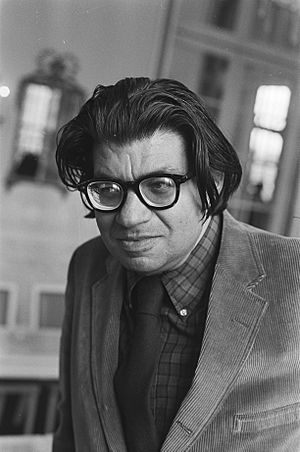Morton Feldman facts for kids
Quick facts for kids
Morton Feldman
|
|
|---|---|

Feldman in 1976
|
|
| Born | January 12, 1926 Queens, New York City
|
| Died | September 3, 1987 (aged 61) |
|
Works
|
List of compositions |
| Spouse(s) |
Barbara Monk Feldman
(m. 1987) |
| Signature | |
Morton Feldman (born January 12, 1926 – died September 3, 1987) was an American composer. He was a very important person in 20th-century classical music. Feldman was a leader in creating "indeterminate music." This means music where some parts are left up to chance or the performer, instead of being strictly written down. He was part of a group called the New York School of composers, which included John Cage, Christian Wolff, and Earle Brown.
Feldman's music often sounds free and flowing, with soft, unclear pitches. It is usually quiet and changes slowly over time, using repeating patterns that are not always even. His later works, after 1977, became very long.
Contents
About Morton Feldman's Life
Feldman was born in Woodside, Queens, New York. His family came from Russia and were Jewish immigrants. His father made children's coats. When he was a child, Feldman learned to play the piano from a teacher named Vera Maurina Press. He said she taught him to love music deeply. His first teachers for composing music were Wallingford Riegger and Stefan Wolpe. Feldman and Wolpe often just talked about music and art together.
Meeting John Cage and New Ideas
In 1950, Feldman went to a concert where he heard a piece by Anton Webern. He was upset by how the audience reacted to it, so he left. In the lobby, he met John Cage, who had also left the concert. They quickly became friends. Feldman even moved into an apartment in the same building as Cage. Through Cage, he met many other artists and composers.
With Cage's encouragement, Feldman started to write music that was very different. It didn't follow old rules about harmony (how notes fit together) or serialism (a way of organizing all the notes). Instead, he tried new ways of writing music. He often used grids in his scores, showing how many notes should be played at a certain time, but not exactly which ones. Feldman's experiments with chance in music even inspired Cage to write his own pieces using similar ideas.
Artistic Inspiration and Later Works
Through Cage, Feldman met many famous artists in New York, like Jackson Pollock and Philip Guston. He found ideas for his music in the paintings of abstract expressionists, who used colors and shapes to show feelings. In the 1970s, he wrote several pieces that were about 20 minutes long. These included Rothko Chapel (1971), written for a building that held paintings by Mark Rothko, and For Frank O'Hara (1973). In 1977, he wrote an opera called Neither with words by Samuel Beckett.
Feldman's music changed a lot in 1970. He stopped using graphic notation (pictures or symbols instead of regular notes) and started writing music with very precise rhythms. The first piece from this new period was a short work called "Madame Press Died Last Week at Ninety," dedicated to his childhood piano teacher.
In 1973, when he was 47, Feldman became a professor at the University at Buffalo. Before this, he worked full-time in his family's textile business. Besides teaching at SUNY Buffalo, he also taught at the University of California, San Diego in the mid-1980s.
Later in his life, Feldman started writing very long pieces of music. They were often played without a break and lasted for half an hour or much longer. Some examples include Violin and String Quartet (1985), which is about 2 hours long, and String Quartet II (1983), which is over six hours long! These pieces usually move very slowly and are mostly very quiet. Feldman said that quiet sounds were the only ones that interested him. He once asked, "Do we have anything in music for example that really wipes everything out? That just cleans everything away?"
Morton Feldman married another composer, Barbara Monk, just before he passed away. He died from pancreatic cancer in 1987 at his home in Buffalo, New York.
Morton Feldman's Compositions
- You can find a full list of his works here: List of compositions by Morton Feldman
Students of Morton Feldman
See also
 In Spanish: Morton Feldman para niños
In Spanish: Morton Feldman para niños

